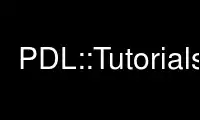
This is the command PDL::Tutorialsp that can be run in the OnWorks free hosting provider using one of our multiple free online workstations such as Ubuntu Online, Fedora Online, Windows online emulator or MAC OS online emulator
PROGRAM:
NAME
PDL::Tutorials - A guide to PDL's tutorial documentation.
MIGRATION
These are our migration guides for users familiar with other types of numerical analysis
software.
PDL::MATLAB
Migration guide for MATLAB users. This page explains the key differences between
MATLAB and PDL from the point of view of a MATLAB user.
PDL::Scilab
Migration guide for Scilab users. This page explains the key differences between
Scilab and PDL from the point of view of a Scilab user.
FOUNDATION
PDL::Philosophy
Why did we write PDL? This document explains some of the history and motivation
behind the Perl Data Language. It is an attempt to answer the question "Why PDL?".
PDL::QuickStart
Quick introduction to PDL features. A hands-on guide suitable for complete beginners.
This page assumes no previous knowledge of Perl or PDL.
PDL::Indexing
After you have read the QuickStart guide, you should follow up with this document.
This guide goes more deeply into the concepts of "indexing" and "slicing" and how
they form the core of numerical analysis with PDL.
INTERMEDIATE
PDL::Threading
Threading is one of PDL's most powerful features. If you know MATLAB, you've heard of
"vectorizing". Well, threading is like "vectorizing on steroids". It lets you make
very fast and compact code by avoiding nested loops. All vector-based languages do
this, but PDL generalizes the technique to all sorts of applications.
This tutorial introduces PDL's threading feature, and it shows an example
implementing Conway's Game of Life in 10 lines and 80 times faster than a classical
implementation.
PDL::BadValues
Sometimes it is useful to specify that a certain value is "bad" or "missing".
Scientific instruments some times include portions of invalid data. For example, a
CCD camera might produce an image with over-exposed pixels. PDL's "bad values"
feature gives you an easy way to deal with this sort of imperfect data.
PDL::Tips
Tips and suggestions for using PDL. This page is an assorted collection of
programming tidbits that some PDL users have found useful. Some of these tips might
be of help when you write your programs.
ADVANCED
PDL::PP
PDL's Pre-Processor is one of PDL's most powerful features. You write a function
definition in special markup and the preprocessor generates real C code which can be
compiled. With PDL:PP you get the full speed of native C code without having to deal
with the full complexity of the C language.
PDL::API
A simple cookbook explaining how to create piddle manually, either from Perl or from
C/XS code. This page covers the PDL core routines that comprise the PDL API. If you
need to access piddles from C/XS, this is the document for you.
PDL::Internals
Description of the inner workings of the PDL module. Very few people need to see
this. This page is mainly for PDL developers, or people interested in debugging PDL
or changing the internals of PDL. If you can read this document and understand all of
it, and you additionally understand PDL::PP, you will be awarded the title of "PDL
Guru".
COPYRIGHT
Copyright 2010 Daniel Carrera ([email protected]). You can distribute and/or modify this
document under the same terms as the current Perl license.
See: http://dev.perl.org/licenses/
Use PDL::Tutorialsp online using onworks.net services
